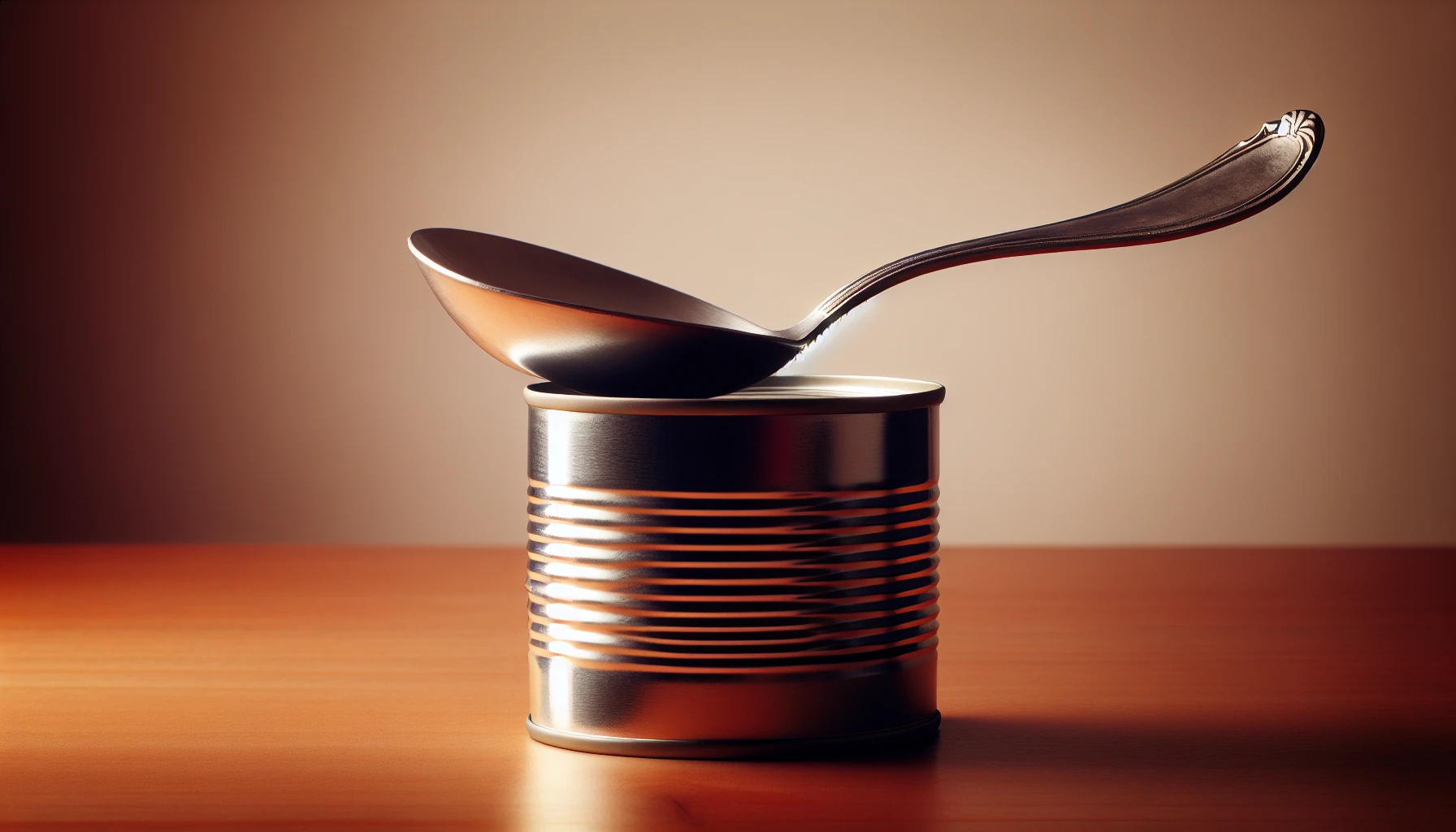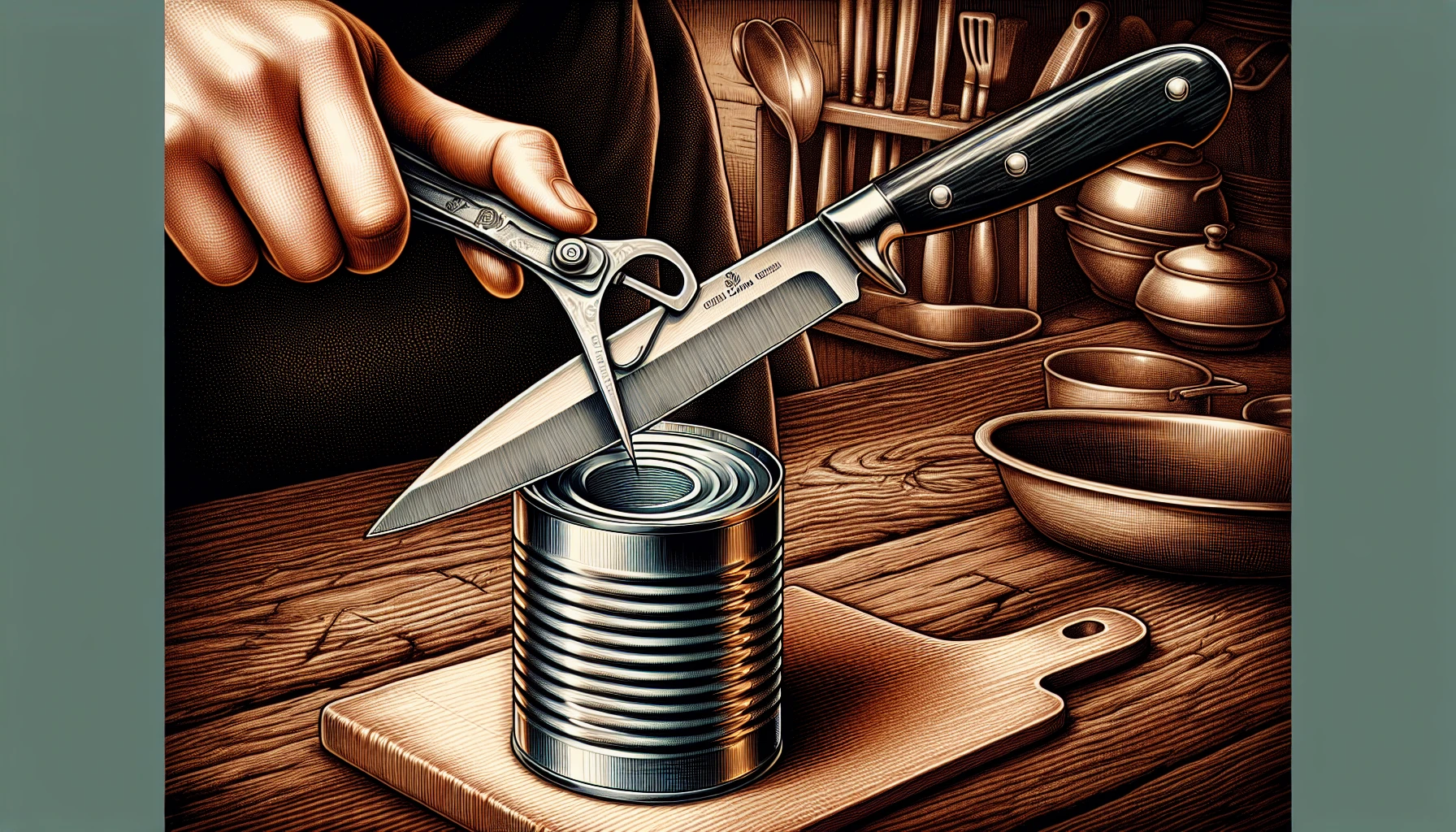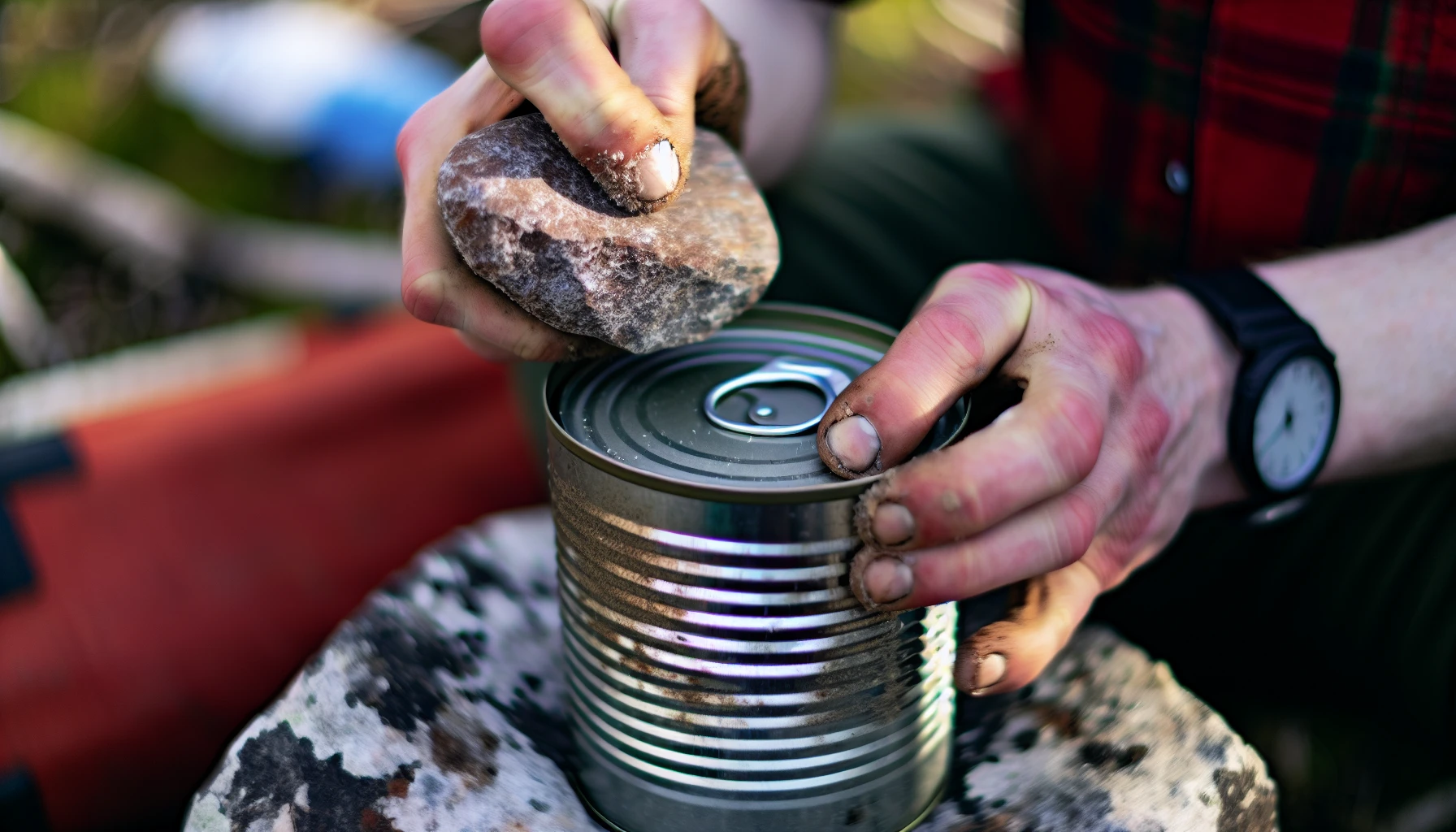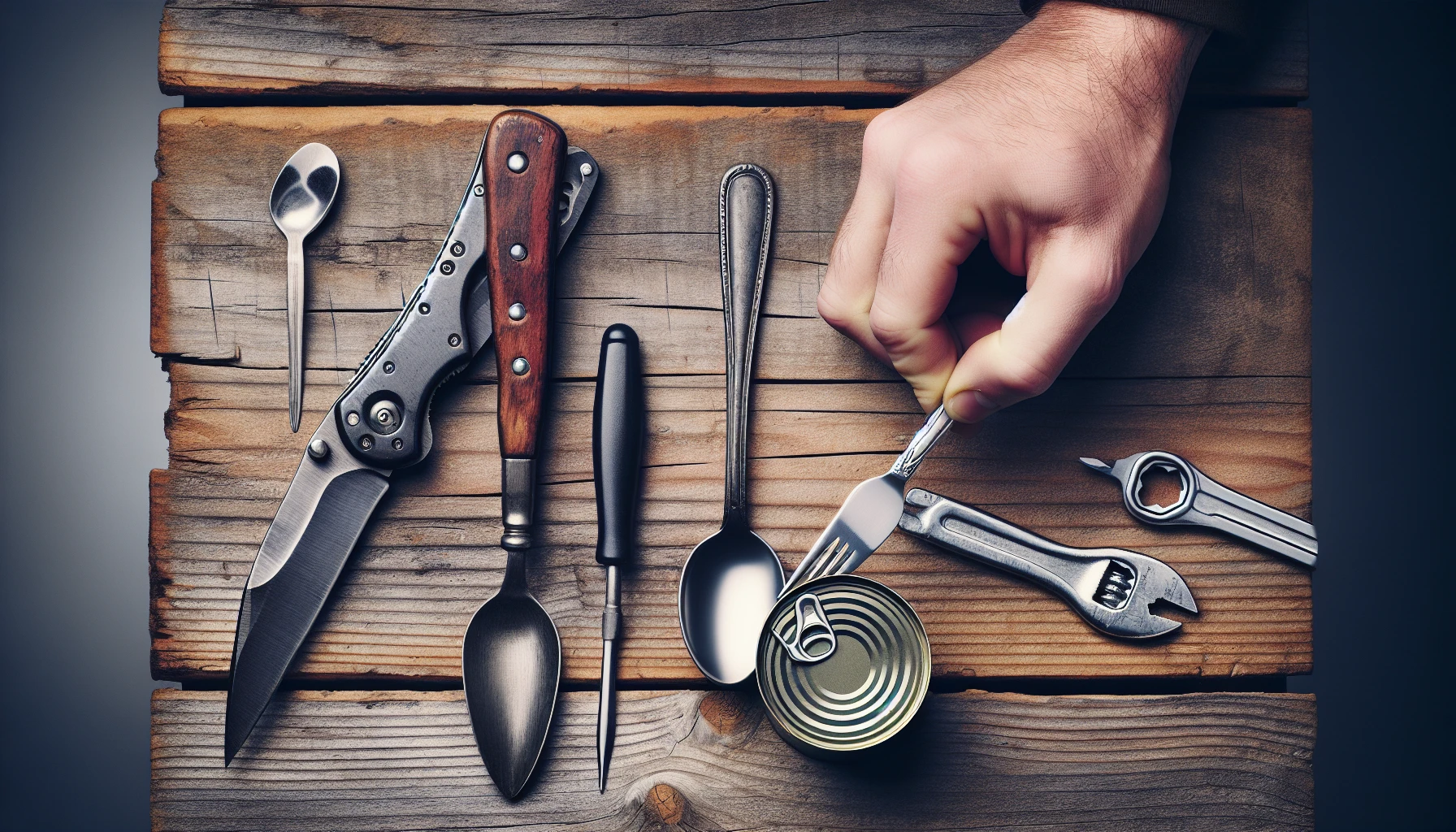5 Ingenious Ways: How to Open Can Without Can Opener – Foolproof Methods!
Panic no more! You don’t need a can opener to enjoy your canned food. From spoons to knives, there are many ways you can learn how to open cans without an opener and become the MacGyver of culinary arts. In this blog post, we will show five foolproof methods for accessing those delicious contents inside tins so that nothing stands between you and enjoying them ever again!
all available resources like rocks or tools around your kitchen - they may come in handy when looking for “how to open can without opening”. Learn our proven techniques here with just some creativity – start now on becoming a master at getting into sealed foods whenever needed.
Key Takeaways
- Unlock cans without a can opener using spoons, knives and other household tools.
- Exercise caution when opening cans to avoid accidents and contamination.
- Wear safety gloves for protection against sharp edges or surfaces.
Unlocking the Can's Contents with a Spoon

If you find yourself without a can opener, using a metal spoon is an easy and effective option to open the can. This method eliminates the risks of producing metal shavings that may happen with knives. Its rounded shape ensures no accidental cuts occur when trying to access contents inside the container.
Choose Your Tool: Selecting a Sturdy Spoon
When it comes to selecting a spoon for can-opening, metal spoons—particularly those made of stainless steel—are the most reliable and sturdy choice. Avoid using plastic or wooden varieties as they may lack the solidity you need for such an endeavor. Look out for features like a good grip along with a sharp edge which will make your task easier and lead you closer to creating that opening in the lid’s edges. Soup spoons are also great options due to their robustness – giving enough leverage needed when going about this method of getting into cans! With an appropriate type of spoon at hand, all that’s left is finding just where exactly on its inner side should be pierced through.
Find the Sweet Spot: Locating the Can's Inner Edge
Identify the can’s raised lip by running your index finger along it. You’ll find this inner edge around the top of the container, use a spoon to leverage that area for opening purposes. Make sure you grip firmly at where handle meets bowl and position tip against lid, applying pressure as necessary while manoeuvering back-and-forth along its outer circumference. Remember too, that with some practice comes proficiency so don’t give up if it takes time to master!
Work It: Rubbing the Spoon Back and Forth
After you have figured out how to carefully locate the inner edge of the can with your spoon and position it correctly, it’s now time for practice. The process requires a lot of effort as well as patience. You need to keep rubbing back and forth on top of the lid until a hole is made in its surface. Continue circling around this spot, making sure that you press against the inside border while keeping an upward angle with your utensil’s tip. Gradually breaking away pieces of metal from all directions, which will enable you to lift off any barriers blocking access to canned goods within. Pay attention not to get hurt when handling open can lids due to their sharp edges!
The Knife Technique: A Sharp Solution

If you need to open a can without the help of an opener, using either a sharp chef’s knife or pocket knife is another feasible alternative. A precise and controlled approach will be necessary as caution should always take priority when attempting this technique. But with sufficient skill and care, it won’t be long before that troublesome lid has been prised off successfully.In these following subsections we’ll outline the processes for both knives in order to unlock your canned goodies!
Knife Selection: Chef's Knife vs. Pocket Knife
For any can-opening job, you have a few options of knives. A chef’s knife is an excellent choice for those seeking substantial and strong blades while pocket knives offer portability and convenience. Butter knives can be used as everyday tools in simpler tasks or if needing something lighter. Swiss army knives provide the most adaptable versatility when attempting various projects. No matter what type of knife you decide to go with, it’s important to remember that safety should always come first so handle each blade with care!
Puncturing the Lid: Creating the Initial Hole
For creating the initial hole, make sure to take the necessary precautions. Begin by placing your can onto a flat and secure surface. Then press carefully on its lid with the tip of your knife handle. Making sure you have a good grip, point the heel of the blade along within the edge rim before applying pressure until there is an opening made in it—be warned that this process may be quite sharp so go slow for safety’s sake!
Circling the Rim: Cutting Around the Can's Lid
Grip the handle of your knife firmly and place its tip to the edge on the inside of the lid. With a vertical hold, cut around by rocking it back and forth as you work around can’s circumference. Be mindful in controlling your blade while taking time. Soon enough, this will enable lifting off for access to all those canned goods! Safety must always be a top priority when utilizing a knife for opening such containers, keep extra caution at hand.
The Rough Way: Utilizing a Flat Rock or Concrete Slab

Without a can opener or spoon/knife, you may find yourself in need of an alternative way to open a can. Using either a flat rock or concrete slab is one possible solution. Simply grind down the lid until it breaks and lifts off! To make this happen, there are certain steps that must be taken first: finding an appropriate type of rock (or other object), doing the grinding process correctly on the lid itself - then lastly removing with ease once sealed broken by your grinder-of-choice.
Preparing the Surface: Finding a Suitable Flat Rock
Finding a suitable flat surface to use for sanding down the lid of the can is essential when using this method. To identify if a rock or concrete slab will be effective, place it upside-down and lightly rub against the top part of the can. If there’s an easy removal then it’s considered appropriate.A hard, level platform should be used in order for enough force and pressure to open up your desired container effectively – keep that information in mind while selecting your surfaces!
Abrasion Action: Sanding Down the Lid
If you have a flat rock or concrete slab, it can be used to open a can without an opener. Begin by placing the metal container upside down on this rough surface and use constant rubbing with back-and-forth strokes which will slowly wear away at the lid. Check regularly for moisture between them before trying to pry off what remains of the top when thin enough. As patience is needed for successful results here, but promises reliable opening when done correctly!
Final Touches: Prying Open the Lid
When it comes to prying open the lid of a can, safety should always be your top priority. Be sure not to rush as sharp edges may cause injury. A multi-purpose tool such as a knife or screwdriver can be used carefully to lift up the edge of the cover. You might also try using a sturdy spoon and creating an opening in order for you to get the purchase around its rim before slowly lifting off the lid from all sides with caution again due to the fact that this contains some sharp elements!
MacGyver Moves: Improvising with Household Tools

Have a look around your house and evaluate what tools you can find to open up that pesky tin! From box cutters, pliers, screwdrivers, or something else, using everyday objects might just be the solution. We will show how to perforate the lid of the can and then remove it completely with these improvised materials in this guide we are about providing.
Assessing Your Arsenal: Choosing the Right Tool
Before beginning to open a can with everyday items, it is important to review the available tools and decide which one would be most appropriate for this task. Assess each instrument in terms of its usability, endurance, safety measures, proficiency and versatility.Some household objects you could use for opening cans include: box cutters. Flat-head screwdrivers, pliers, scissors, every item must not only puncture through the lid but also handle safely while operating them.
Take into consideration that selecting an effective yet secure tool will help complete this job effectively as well as comfortably.
Making the Cut: Penetrating the Can Lid
Once you have your chosen tool in hand, it’s time to start puncturing the lid of the can. The technique for punching a hole into this surface depends on which instrument is used. If using a box cutter, you should turn the tip counterclockwise while pressing down at once and cutting as you go along. To create an opening with a screwdriver, tapping lightly with some kind of hammer might be necessary firstly.Regardless of what method is preferred here, safety must come first when making any holes or gaps and so caution has to be exercised throughout this process always!
Lifting Off: Removing the Entire Lid
Before tackling the task of opening a can, ensure your safety by being attentive to sharp edges. To remove the lid entirely, you must use caution when handling whatever tool was selected. For example, a box cutter’s tip may be used to prize it off or cut around its edge as an alternative method. Whatever approach is chosen, make sure that all steps are taken with care in order not to sustain injury due to any threateningly sharp details.
Safety First: Protective Measures When Opening Cans

No matter the opener used to access a can without an official can opener, safety must be maintained at all times. Consideration for protection of hands as well as attention to potential sharp edges is important in order to prevent any accidents or contamination from occurring. Maintaining cleanliness and using openers that are not overly sharp should help keep everyone safe during this process.
Hand Protection: The Role of Safety Gloves
To prevent getting cuts when using a can opener, wearing safety gloves is essential. Cut-proof or leather protective gloves provide excellent coverage for your hands and reduce the chances of any injuries due to sharp objects present during this process. It should be noted that such measures are especially necessary when relying on alternative methods, as they may increase hazards compared with traditional openers. To ensure proper protection while operating an opener, it’s crucial to make sure those gloves fit tightly and are in good condition prior to use.
Dealing with Sharp Edges: Minimizing Risks
It’s important to take into account the safety elements involved when opening cans, such as sharp edges. The use of a knife or spoon can create dangerous points and it is therefore critical to exercise caution while handling these tools. Make sure you grip firmly onto your selected implement and be intentional in all movements during this process so that an accident does not occur. If feasible, select techniques which blunt the sharpness at some degree for increased protection from harm.
Cleanliness is Key: Avoiding Contamination
Cleanliness is essential for the successful opening of cans in order to guarantee that your food will remain safe. Unclean hands, tools or contact with hazardous materials can all cause contamination. It is important to thoroughly clean yourself and any equipment before and after you open a can. If using an irregular material such as a rock or concrete slab, ensure they are without dirt before use. This helps prevent potential health risks from occurring due to harmful contaminants being present on unhygienic surfaces. All these steps must be taken into consideration when wanting secure foods free of pollutants for consumption purposes.
Summary
Without a traditional can opener, accessing your favorite canned food items may seem like an insurmountable challenge. But with the right know-how and improvisation skills, you too can open cans without relying on this kitchen tool. From using a spoon or knife to finding alternative household tools such as pliers or scissors — or even rough surfaces like rocks and concrete slabs — there are plenty of creative ways to get into those delicious meals that come in all shapes and sizes!Safety first is key when attempting any of these methods. It’s essential for keeping cleanliness at its best so your tasty meal remains uncontaminated. With the above techniques mastered, no pesky tin will be left unturned– don’t let being without an opener stand between you enjoying what’s inside!
Frequently Asked Questions
Is it possible to open a can without a can opener?
It is possible to open a can without requiring the use of an actual opener. Rather, one could take advantage of sharper objects such as knives or spoons that are thicker and stronger than the lid itself in order to pierce it along its rim edge. A chef knife can also be employed for this process with reliable results. By wearing away at these edges gradually, eventually opening up the container will become viable without using any other type of equipment whatsoever.
Can you open a can with a screwdriver?
Yes, you can open a can with a flat-head screwdriver. Carefully place it inside the rim of the can and tap it with a hammer to puncture the lid. Be careful though; use caution to avoid injury.
How do you open a can with a key?
Using a key, grab the tab on top of the can and twist it to puncture the lid. Then use either a spoon or butter knife in order to pry open carefully, taking extra caution as you do so as not to break your key.
Can you open can with scissors?
Scissors can be used to open an aluminum or steel can, specifically a pair of strong kitchen scissors should puncture the rim and carefully cut around it.
What types of spoons are best for opening a can without a can opener?
Using a spoon, such as a soup or serving spoon, is the best method for opening up any can without an actual opener. The strength of these spoons gives you enough leverage to make quick work out of it.